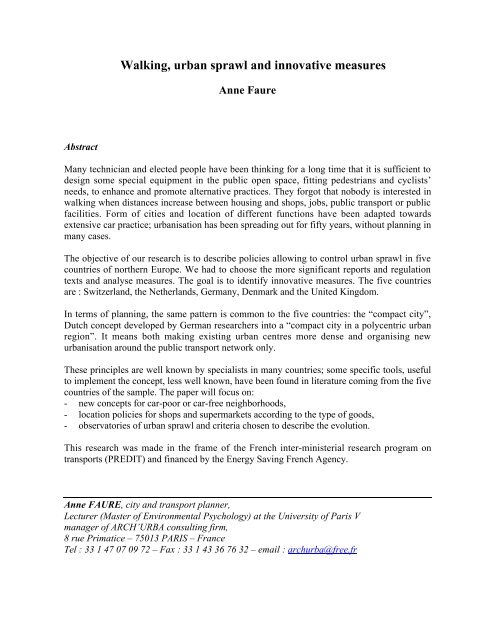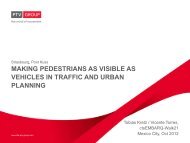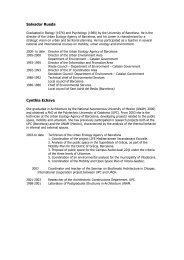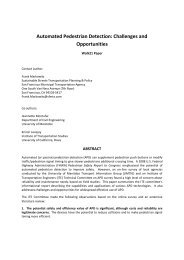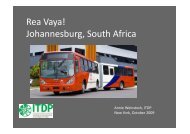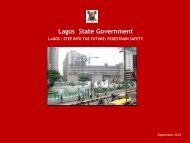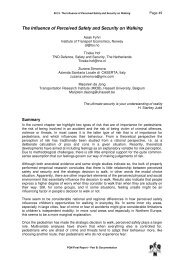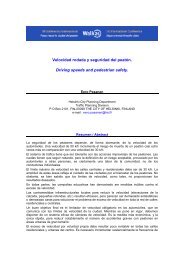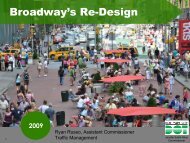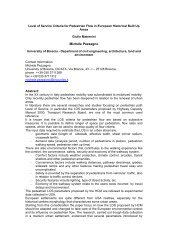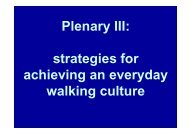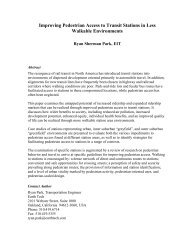Download Walking, urban sprawl and innovative measures ... - Walk21
Download Walking, urban sprawl and innovative measures ... - Walk21
Download Walking, urban sprawl and innovative measures ... - Walk21
You also want an ePaper? Increase the reach of your titles
YUMPU automatically turns print PDFs into web optimized ePapers that Google loves.
Abstract<br />
<strong>Walking</strong>, <strong>urban</strong> <strong>sprawl</strong> <strong>and</strong> <strong>innovative</strong> <strong>measures</strong><br />
Anne Faure<br />
Many technician <strong>and</strong> elected people have been thinking for a long time that it is sufficient to<br />
design some special equipment in the public open space, fitting pedestrians <strong>and</strong> cyclistsÕ<br />
needs, to enhance <strong>and</strong> promote alternative practices. They forgot that nobody is interested in<br />
walking when distances increase between housing <strong>and</strong> shops, jobs, public transport or public<br />
facilities. Form of cities <strong>and</strong> location of different functions have been adapted towards<br />
extensive car practice; <strong>urban</strong>isation has been spreading out for fifty years, without planning in<br />
many cases.<br />
The objective of our research is to describe policies allowing to control <strong>urban</strong> <strong>sprawl</strong> in five<br />
countries of northern Europe. We had to choose the more significant reports <strong>and</strong> regulation<br />
texts <strong>and</strong> analyse <strong>measures</strong>. The goal is to identify <strong>innovative</strong> <strong>measures</strong>. The five countries<br />
are : Switzerl<strong>and</strong>, the Netherl<strong>and</strong>s, Germany, Denmark <strong>and</strong> the United Kingdom.<br />
In terms of planning, the same pattern is common to the five countries: the Òcompact cityÓ,<br />
Dutch concept developed by German researchers into a Òcompact city in a polycentric <strong>urban</strong><br />
regionÓ. It means both making existing <strong>urban</strong> centres more dense <strong>and</strong> organising new<br />
<strong>urban</strong>isation around the public transport network only.<br />
These principles are well known by specialists in many countries; some specific tools, useful<br />
to implement the concept, less well known, have been found in literature coming from the five<br />
countries of the sample. The paper will focus on:<br />
- new concepts for car-poor or car-free neighborhoods,<br />
- location policies for shops <strong>and</strong> supermarkets according to the type of goods,<br />
- observatories of <strong>urban</strong> <strong>sprawl</strong> <strong>and</strong> criteria chosen to describe the evolution.<br />
This research was made in the frame of the French inter-ministerial research program on<br />
transports (PREDIT) <strong>and</strong> financed by the Energy Saving French Agency.<br />
Anne FAURE, city <strong>and</strong> transport planner,<br />
Lecturer (Master of Environmental Psychology) at the University of Paris V<br />
manager of ARCHÕURBA consulting firm,<br />
8 rue Primatice Ð 75013 PARIS Ð France<br />
TelÊ: 33 1 47 07 09 72 Ð FaxÊ: 33 1 43 36 76 32 Ð emailÊ: archurba@free.fr
<strong>Walking</strong>, <strong>urban</strong> <strong>sprawl</strong> <strong>and</strong> <strong>innovative</strong> <strong>measures</strong><br />
Anne Faure<br />
Many technician <strong>and</strong> elected people have been thinking for a long time that it is sufficient to<br />
design some special equipment in the public open space, fitting pedestrians <strong>and</strong> cyclistsÕ<br />
needs, to enhance <strong>and</strong> promote alternative practices. They forgot that nobody is interested in<br />
walking when distances increase between housing <strong>and</strong> shops, jobs, public transport or public<br />
facilities. The form of cities, the location of different functions have been adapted towards an<br />
extensive car practice; <strong>urban</strong>isation has been spreading out for fifty years, without planning in<br />
many cases.<br />
The objective of our research is to describe policies allowing to control <strong>urban</strong> <strong>sprawl</strong> in five<br />
countries of northern Europe. We had to choose the more significant reports <strong>and</strong> regulation<br />
texts <strong>and</strong> to analyse the <strong>measures</strong>. The goal is to identify <strong>innovative</strong> <strong>measures</strong>. The five<br />
countries are : Switzerl<strong>and</strong>, the Netherl<strong>and</strong>s, Germany, Denmark <strong>and</strong> the United Kingdom.<br />
This research was made in the frame of the French inter-ministerial research program on<br />
transports (PREDIT) <strong>and</strong> financed by the Energy Saving French Agency.<br />
Method<br />
Available information is presented, first by five case-studies which described policies lead in<br />
the different countries, second, by thematic analyses concerning the different types of<br />
<strong>measures</strong>:<br />
- densification strategies,<br />
- regulation <strong>and</strong> institutional tools,<br />
- economical tools,<br />
- infrastructure policies.<br />
In some cases, <strong>innovative</strong> <strong>measures</strong> have been chosen <strong>and</strong> analysed in more detail.<br />
General results<br />
In terms of planning, the same pattern is common to the five countries : the Òcompact cityÓ,<br />
Dutch concept developed by German researchers into a Òcompact city in a polycentric <strong>urban</strong><br />
regionÓ. It means both making existing <strong>urban</strong> centres more dense <strong>and</strong> organising new<br />
<strong>urban</strong>isation around the public transport network only.<br />
The efficiency level produced by adopted strategies seems to be facilitated by long term<br />
policies <strong>and</strong> the coherence with <strong>measures</strong> in every field: housing, public facilities, activities...<br />
The part played by economy tools is regarded by many authors as a priority.
Available evaluations are not really optimistic. However, except in Switzerl<strong>and</strong>, the policies<br />
are too recent to have a significant influence on <strong>urban</strong> morphology. The principal obstacle<br />
seems to be the lacking awareness of the consequences of <strong>urban</strong> <strong>sprawl</strong> among citizens <strong>and</strong><br />
elected people. Arguments found in literature coming from the five countries of the sample<br />
could be helpful to make people underst<strong>and</strong> better the relationship between walking <strong>and</strong> the<br />
result of <strong>urban</strong> policies.<br />
The principles of Òthe compact-city in a polycentric <strong>urban</strong> regionÓ are well known, but some<br />
specific tools are useful to implement the concept.<br />
The paper will focus on :<br />
- new concepts for car-poor or car-free neighborhoods,<br />
- location policies for shops <strong>and</strong> supermarkets according to the type of goods,<br />
- observatories of <strong>urban</strong> <strong>sprawl</strong> <strong>and</strong> criteria chosen to describe the evolution.<br />
Building car-poor or car-free neighborhoods<br />
In 1992, in Amsterdam, local authorities decided to create an ecological district in<br />
Westerpark, not far from the city centre. The program, supported by the government, had to<br />
reach the density of 100 apartments per hectare, which is relatively high. The solution found<br />
to deal with the constraint <strong>and</strong> propose a high quality of life was to adopt 0,3 as parking rate<br />
(one parking space for three apartments, for guests <strong>and</strong> delivery). This made possible an<br />
organisation where every apartment could benefit of a terrace or a private garden. This<br />
experiment opened a large range of programs where walking is facilitated.<br />
The objectives to build car-poor neighborhoods are:<br />
- to propose a new way of life in <strong>urban</strong> districts,<br />
- to take advantage of the observed low car-ownership of the inhabitants,<br />
- to save the price of the l<strong>and</strong> corresponding to parking spaces,<br />
- to reduce costs <strong>and</strong> propose better services,<br />
- to increase quality of life <strong>and</strong> security.<br />
Two types of programs can be sorted out according to the parking rate ( 0 to 0, 5 ): car free or<br />
dense neighborhoods. Different solutions have been implemented within the two categories.<br />
In the case of new buildings, like for old houses refurbished, the design aims to take<br />
advantage of the absence of car <strong>and</strong> make the inhabitants profit by it. The reduced cost of l<strong>and</strong><br />
allows to produce less expensive housing <strong>and</strong> to offer more facilities.<br />
A study lead by ISL in Dortmund (Gout <strong>and</strong> Kron), concerning the numerous German<br />
experiments, observes that the location of such neighborhoods is the main point: walking is<br />
more enjoyable when shops <strong>and</strong> services can be reached at a short distance. These new<br />
neighborhoods are located in peripheral area <strong>and</strong> close to an interchange station of public<br />
transport. Existing car-sharing organization, pedestrians <strong>and</strong> cycle paths, home delivery<br />
services, are important criteria for the success of the project.<br />
Many programs are developing in the Netherl<strong>and</strong>s, Germany, Austria or United Kingdom. In<br />
some German LŠnder, planning regulation <strong>and</strong> laws have been changed to make less rigid the<br />
obligations in parking rate. These new neighborhoods show that density <strong>and</strong> quality of life are<br />
compatible.
Developing new types of <strong>urban</strong> housing<br />
Walkable neighborhoods have to provide a good quality in housing <strong>and</strong> in design of public<br />
open space to be a realistic alternative.<br />
A research lead in France recently (CERTU Ð Kaufmann, Jemelin, Guidez- 2000) showed that<br />
the reasons which decide many people to live in the suburbs are not a choice but the result of<br />
financial constraints. It seems that the offer in housing of French city centers is not fitting<br />
with the dem<strong>and</strong>, specially for families with children.<br />
People cannot imagine life without a car in any country. In many cases, the high cost of a big<br />
apartment well served by public transport makes low income inhabitants live far from shops,<br />
services <strong>and</strong> facilities: they become dependent on car. Low cost dwellings are generally<br />
located at a large distance from a bus or a railway station. However, the evolution of<br />
demography brings a new context to design the city of the future.<br />
The increasing number of aging population, of people living alone, of people bringing up<br />
children alone characterize the evolution of demography. But the context is also changed by<br />
new technologies, which organize working rhythm differently. Flexibility produces times of<br />
unemployment which can be used for home education. Part time jobs are developing. It seems<br />
that the time spent at home will be longer. The Ò short distance cityÓ is a good environment<br />
for this future way of life.<br />
Living in a small city center or a neighborhood center, without the daily use of a private car,<br />
is possible when the level of the rent decreases <strong>and</strong> the quality of life <strong>and</strong> services increase.<br />
Families need large surface apartments, private open space (garden or terrace), well<br />
maintained public open space, schools <strong>and</strong> kindergarten close to their houses. Existing public<br />
transport is one of the conditions to convince the inhabitants to live in a walkable community,<br />
but not sufficient.<br />
In the suburbs, the inhabitants can enjoy free spaces, green spaces <strong>and</strong> feel closer to nature. It<br />
is important that they can reach a public garden at a small distance from home when they<br />
think about moving to <strong>urban</strong> districts. If city design includes green spaces, pedestrian paths,<br />
trees in the public open spaceÉ, a small private garden or terrace is more acceptable.<br />
A walkable community is a global concept where city-planning, city-design <strong>and</strong> housing -<br />
design are linked. Row houses with small gardens, low condominiums with terraces or private<br />
gardens for the ground floor need few surface of l<strong>and</strong>. The density of these architectural forms<br />
can be relatively important, though the height of buildings is not, <strong>and</strong> the green environment<br />
is enjoyable for pedestrians.<br />
New forms of l<strong>and</strong> saving dwellings with gardens are still to imagine with the intention to<br />
propose homes for families at a short distance from public transport <strong>and</strong> shops. The challenge<br />
is to reduce the attraction of suburbs by increasing the interest of <strong>urban</strong> housing.<br />
Urban <strong>sprawl</strong> is generally considered as unavoidable. Private car ownership, country housing<br />
for people working in cities are not only influenced by a global change but also by political<br />
decisions. Road policies, tax policies, railways policies contribute to <strong>urban</strong> <strong>sprawl</strong>. Planning<br />
regulation, which plays a large part in the process, can evolve.
Implementing location policies for shops <strong>and</strong> supermarkets<br />
The location of supermarkets, of shops <strong>and</strong> leisure centres evolved according to the same<br />
pattern in many developed countries. Supermarkets <strong>and</strong> leisure centres establish in the<br />
suburbs far from <strong>urban</strong> centres to profit of low cost l<strong>and</strong> <strong>and</strong> to build huge car parks : the<br />
systematic use of the private car to go <strong>and</strong> shop or practice a sport is considered as obvious.<br />
Supermarkets <strong>and</strong> service decentralization creates an important number of week-end <strong>and</strong> daily<br />
trips, with consequences in terms of pollution <strong>and</strong> noise. In some European cities, like<br />
Freiburg im Brisgau in Germany for example, at the level of <strong>urban</strong> regions, like Bern or<br />
Lucern in Switzerl<strong>and</strong>, or a whole country, like in the Netherl<strong>and</strong>s, local authorities decided to<br />
organise the location of new shops <strong>and</strong> supermarkets according to the type of goods <strong>and</strong><br />
services offered.<br />
Some principles inspired the rules adopted by the different governments :<br />
- shops for daily or week-end purchases must be close to residential areas, within a radius<br />
of _ kilometre, to be reached by foot, by bicycle or with public transports,<br />
- monthly or uncommon shopping must be possible in city centres, in small towns, <strong>and</strong> in<br />
neighbourhood centres, in big cities,<br />
- goods which size, weight or nature need the use of a car must be on sale in specialised<br />
shopping centres, accessible by highways <strong>and</strong> defined by l<strong>and</strong> use plans.<br />
This kind of organisation, relevant for sustainable development, needs a change in shop<br />
supply (more often, with small lorriesÉ) <strong>and</strong> other <strong>measures</strong> like free home delivery or better<br />
use of Internet.<br />
In large cities, where public transport is efficient, the rents are more expensive in residential<br />
areas than in industrial estates, but the density of population <strong>and</strong> the vicinity of other shops<br />
create more customers <strong>and</strong> more benefit.<br />
In small cities, local authorities have to launch global politics of <strong>urban</strong> regeneration to<br />
enhance shopping, including housing, traffic calming programs, pedestrian streetsÉ<br />
Urban neighbourhoods are a good scale to organise <strong>urban</strong> centres bringing together public<br />
facilities <strong>and</strong> shops. Schools focus city life. <strong>Walking</strong> is enjoyable <strong>and</strong> contributes to develop<br />
social life.<br />
In Freiburg-im-Brisgau, between 1984 <strong>and</strong> 1990, neighborhood centres were loosing their role<br />
of supply, their interest <strong>and</strong> dynamics, while sale surfaces was increasing in industrial estates<br />
in the suburbs. A study of IREC/EPFL in Lausanne (Bonanomi <strong>and</strong> Thalmann) reports how<br />
local authorities reacted. They feared that, if shops were disappearing, other services, doctors<br />
or cultural facilities could disappear <strong>and</strong> social <strong>and</strong> cultural life could decline.<br />
Local authorities took <strong>measures</strong> to facilitate <strong>and</strong> change the projects of new commercial<br />
surfaces towards city <strong>and</strong> neighborhood centres so that supplies in daily needs could be<br />
available <strong>and</strong> to stimulate competition between shopkeepers. In addition, a list of goods which<br />
could not be sold in sub<strong>urban</strong> shopping centres has been established. This program was called<br />
Ò Markets <strong>and</strong> centres conceptÓ.
Creating observatories to survey <strong>urban</strong> <strong>sprawl</strong><br />
Some countries are trying to implement tools with the intention to measure <strong>urban</strong> <strong>sprawl</strong> <strong>and</strong><br />
to evaluate the effects on the environment.<br />
In Switzerl<strong>and</strong> in 1983, boards were created at different scales (local authorities <strong>and</strong> federal<br />
government) to observe the evolution of territories with the contribution of both statistics <strong>and</strong><br />
maps. The goal is to underst<strong>and</strong> the difference between what was planned <strong>and</strong> what exists.<br />
The targets, set by the federal government, are:<br />
- to study l<strong>and</strong> use <strong>and</strong> organization of the territory,<br />
- to solve concrete problems of <strong>urban</strong> development,<br />
- to help decision-making in city <strong>and</strong> regional planning,<br />
- to make a survey of the developing process.<br />
The information is produced to be taken into account by political <strong>and</strong> economical decision -<br />
makers, to be used as a basis for federal documents, <strong>and</strong> also, to be held at citizensÕ disposal<br />
<strong>and</strong> proposed to the media.<br />
In the ZŸrich area, the observatory was launched in the seventies, which now allows to make<br />
interesting comparisons. More recently, local authorities of Vaud (Geneva <strong>and</strong> Lausanne) is<br />
building an information system , Internet oriented, which is composed of maps, statistics <strong>and</strong><br />
analyses. These comments aim to explain the evolution revealed by different criteria.<br />
The choice of criteria is discussed in many reports. According to many authors, l<strong>and</strong> -<br />
consumption is the best indication to measure <strong>urban</strong> <strong>sprawl</strong>. The studies made in Berlin by<br />
DIFU (Deutsches Institut FŸr Urbanistik Ð Apel <strong>and</strong> al.) come to the conclusion that <strong>urban</strong><br />
<strong>sprawl</strong> can be measured by:<br />
- general l<strong>and</strong>-consumption of <strong>urban</strong> space <strong>and</strong> traffic (surface / number of inhabitant)<br />
- detailed l<strong>and</strong>-consumption of buildings <strong>and</strong> roads (surface / number of inhabitant)<br />
- presence of transport network (rail <strong>and</strong> road) in free spaces ( km / km_)<br />
- private car ownership rate (/ 1000 inhabitants)<br />
- public transport supply, comfortable space for pedestrians <strong>and</strong> cyclists,<br />
- surface of the public open space,<br />
- density rate <strong>and</strong> mixed-uses in the neighborhoods.<br />
The range of criteria is more open in ZŸrich than the German proposition:<br />
- demography, sociological <strong>and</strong> cultural indicators,<br />
- detailed description of l<strong>and</strong> use,<br />
- height of buildings, <strong>urban</strong>ization rate of future <strong>urban</strong> extensions,<br />
- surface of agricultural l<strong>and</strong> <strong>and</strong> forests, percentage of built surfaces in agricultural zones,<br />
- transportation mode used for different kind of trips, by commuters;<br />
The use of maps, made possible by computerization of data, is important as a pedagogical<br />
tool: visual documents are generally more clear than statistic tables.
Lobbying for walkable-neighborhoods<br />
In many countries, where people are aware of environmental issues for a long time, advocacy<br />
organizations use to fight for ecological mobility, quality of life <strong>and</strong> road safety. Many of<br />
them, however, do not identify the relationship existing between problems at the scale of the<br />
neighborhood <strong>and</strong> global planning of the <strong>urban</strong> region. Lobbying against <strong>urban</strong> <strong>sprawl</strong> is<br />
unusual.<br />
But, the situation will not evolve if citizens do not put pressure on political bodies. Some<br />
elected people are aware of the danger of environmental problems. They can act if their<br />
population is ready to support them, because the car lobby is strong <strong>and</strong> efficient everywhere.<br />
Concepts like Òshort distance citiesÓ, fight against <strong>urban</strong> <strong>sprawl</strong> <strong>and</strong> car poor-neighborhoods<br />
or walkable-neighborhoods are not well known, partly because media are not interested in<br />
such subjects. Sustainable development <strong>measures</strong> belong to a complex process, difficult to<br />
explain <strong>and</strong> rejected by many people.<br />
Dense neighborhoods are a response to the needs of the future: changes in demography <strong>and</strong> in<br />
professional practices. One of the most important tasks is to convince people that walking<br />
remains a transport mode.<br />
References<br />
ÇÊSzenarien und Potenziale einer nachhaltig flŠchensparenden und l<strong>and</strong>schaftsschonenden<br />
SiedlungsentwicklungÊÈÊ<br />
DIFU - directed by Dieter Apel Ð Berlin 2000.<br />
ÇÊTowards an Urban RenaissanceÓ<br />
Final report of the ÒUrban Task ForceÓÊchaired by Lord Rogers of Riverside Ð Spon 1999.<br />
ÒVers un <strong>urban</strong>isme de la proximitŽÓ<br />
Lydia Bonanomi (IREC/ EPF Lausanne), National Research Program 41Ê: Transport <strong>and</strong><br />
Environment, Swiss National Science Foundation Ð Bern 2000.


